When I was a new homeowner, I cut my Turf-type Tall Fescue (TTTF) grass at 2" all summer and it looked terrible. I eventually learned that mowing height affects the health of my grass. Properly setting the height at which I cut my grass has hugely improved the look and health of my grass.
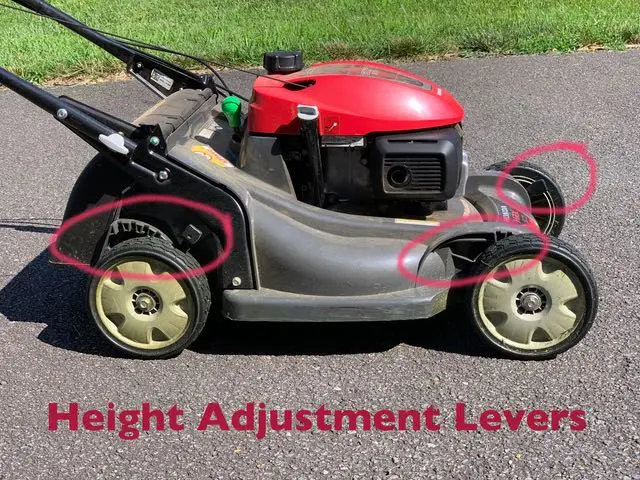
Front and Rear Mowing Height Adjustment Levers
My area experienced 95+ F temperatures in mid-June. Before the extremely hot, humid temperatures arrived, I raised the cutting height on my Honda HRX217HYA lawnmower from 3 inches to 3.5 inches. My goal was to help my grass survive the intense heat.
NOTE: This post applies only to cool-season grass (TTTF, Rye, Kentucky Blue Grass/KBG). Not sure whether you have warm-season or cool-season grass? If your grass struggles in the summer heat, it is likely cool-season grass. If it thrives and grows like crazy, it is likely warm-season grass.
What is Mowing/Cutting Height?
Mowing height can be defined as:
- The distance from the ground to the top of the grass blade, immediately after the grass has been cut.
- The distance from the ground to the bottom of the lawnmower’s cutting blade.
For example, if your cutting height is 3", then the lawnmower has been adjusted so that the bottom of the cutting blade is 3" above the ground. And immediately after the grass has been cut, each grass blade is a maximum of 3" tall.
Why Raise Cutting Height in Summer?
Several factors affect how high you should allow your grass to grow in summer:
- Grass type – TTTF likes to be mowed high (3-4 inches), while KBG can be mowed low (1-2.5 inches).
- Sun versus shade – Grass grown in the shade can be cut shorter, while grass in full sun should be cut higher.
- Outdoor temperatures – When it is hot, cut your grass higher (I raise my cutting height from 3 inches to 3.5 inches every summer, and may raise to 4 inches if temps in the 90s persist). Cutting higher allows the grass blades to shade the grass roots so they dry out less quickly, and collect more morning dew.
- Mower limitations – most residential mowers can cut grass between 1 and 4 inches. Reel mowers can mow lower than 1 inch (example: golf course putting green), and commercial mowers can cut higher than 4 inches.
Does your grass look yellow for a day or two after each mow? If yes, this means that you are mowing too low (that is, removing too much of the grass blade when you mow). Your grass is stressing for a day or two after the mow, then recovers (if it is super dry / hot and cut too low, the grass might be damaged rather than recover). Mowing services often cut grass too low, because the homeowner only wants to pay them to cut the grass every two weeks and thus the mowing service must “scalp” the grass to keep it from growing too high between mows.
A lawncare rule of thumb is to never cut off more than 1/3 of the grass blade. So if your grass is 3" high, don’t cut it lower than 2" (3"x2/3). If your grass is 6" high, don’t cut it lower than 4" (6"x2/3). Yes, a retired engineer can find a way to insert math into grass cutting!
Note that the “1/3 rule” is a recommendation not a law. Most of us have jobs and priorities other than lawncare. When it rains for a week straight and the grass is 6" high and you need to cut it to 3", go for it – but know that you will stress the grass for the two days.
In general, try not to cut more than 1/3 off the grass blade at a time. But if you have to cut more than that, the grass will probably survive. Just don’t make a habit of cutting it from 6" to 3" every two weeks. In a perfect world, desired and actual grass height will dictate how often you mow.
I suggest experimenting with your mowing height based on the info above. For my yard (TTTF, full sun, hot summers), a mowing height of 3" works well in spring/fall, but during summer’s heat I cut at 3.5" or 4" (especially when it is dry).
Note that another reason to avoid cutting the grass too low is that this can cause the cut grass to clump, and the clumps tend to kill the grass. See the photo below for an example of grass that wasn’t cut often enough, resulting in clumps which will yellow and then kill the grass under the clumps. If you do end up with clumps when you cut, the best way to disperse this is with a leaf blower.
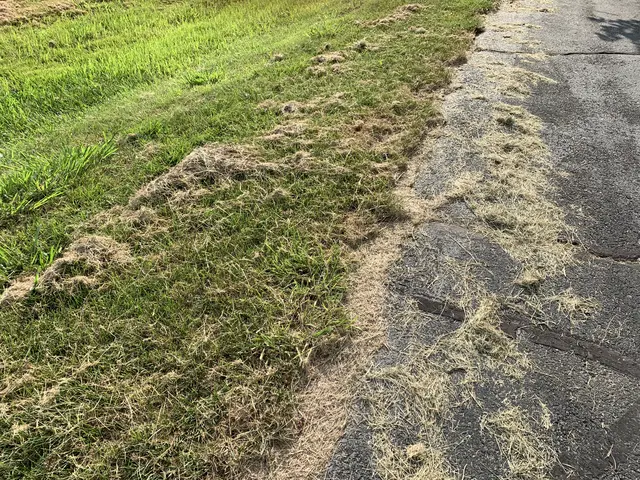
Grass Clumps from Cutting Grass Too Low
How to Raise Mower Cutting Height
Most mowers have four cutting height adjustment knobs – one near each wheel. Moving the knob forward or backwards raises or lowers the height of the cutting deck and thus the cutting height of the mower.
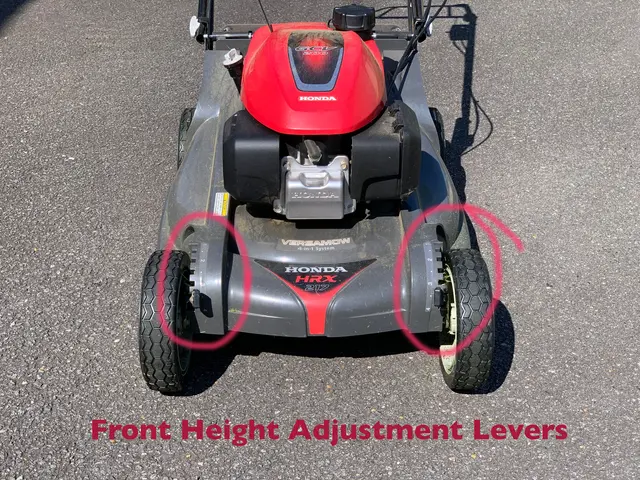
Front Mowing Height Adjustment Levers
All knobs should be set to the same cutting height. If they are set to different heights, the mower will wobble when pushed across a flat surface such as a driveway or sidewalk. The only exception to this is that you may raise the height of the front wheels when mulching leaves in the fall.
Height adjustment knobs are typically labeled, but usually with a code rather than an actual cutting height. I suspect manufacturers do this so they can sell mowers both in the US (which uses English units) and the rest of the world (which uses metric). My Honda HRX217 has seven height positions. These are labeled 1, 2, 3, and 4. The adjustment knob can be set to one of these numbers, or between the numbers. To raise my cutting height from 3" to 3.5" inches, I moved each adjustment knob from “3” to between “3” and “4”.
If your mower has a single height adjustment knob, move that single knob to raise or lower the height of all four wheels.
Verify that the mower is stable after adjusting by pushing in on a hard, flat surface such as a driveway or sidewalk. The mower should not wobble.
The photos below show a lawn mower adjusted to 3.5" cutting height, and to 1" cutting height. Note that went cutting the grass low, you are more likely to hit obstacles such as sprinkler heads, rocks, etc. I’ve managed to accidentally scalp the tops off some of my sprinkler heads when cutting low.
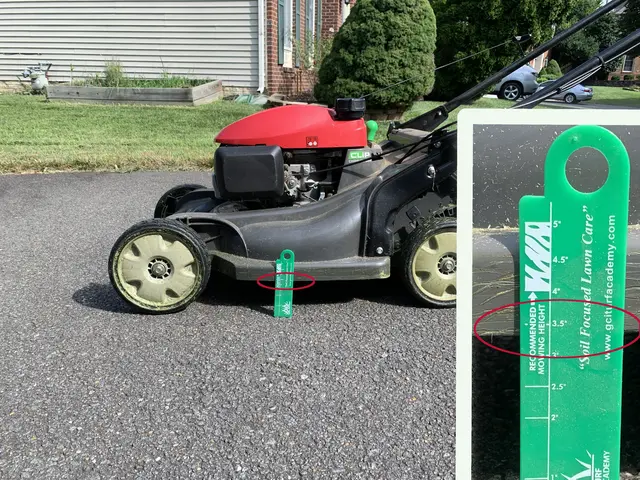
Mowing Height Set to 3.5 Inches
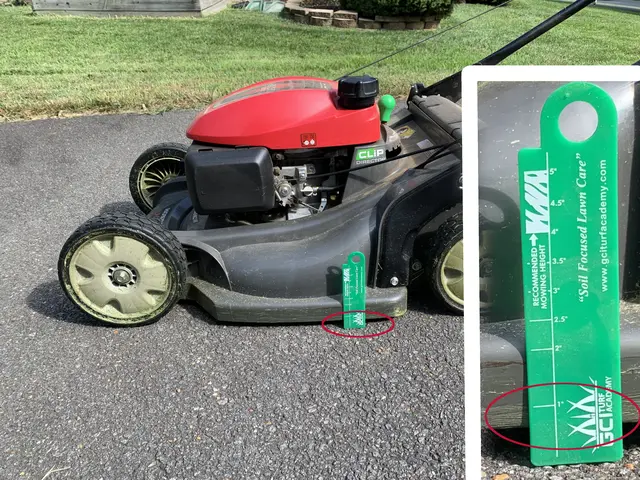
Mowing Height Set to 1 Inch
Recommendations for Good-looking Summer Grass
These are listed in priority order:
- Raise cutting height <– easiest and cheapest trick also works the best!
- Water at least 1" per week (1.5" when it is really hot)
- Fertilize with a low-N, high-K slow-release fertilizer
Good luck helping your cool-season grass survive the summer heat!